|
|
"Oh sure!"
The Manta Ray Plays Trikcs with Human Perception
by Bruce Cornet, Ph.D.
Table of Contents
Unusual Phenomena Recorded at Jewish Cemetery
On 4 September 1992 Ellen Crystall took Cornet and Fred Brock to the Jewish Cemetery along Rte 52 between Pine Bush and Walden to look for AOP. That night watch location was one of her favorites (Crystall, Silent Invasion, 1991). She hoped to get a supportive article written by Brock in the Wall Street Journal, where Brock worked as a reporter and editor. His boss had given him an assignment to cover the Pine Bush sightings, but when Brock submitted an article that was favorable towards the existence of a phenomenon rather than one which ridiculed the people who thought UFO meant extraterrestrial space craft, his boss would not publish it. Brock quit his job in disgust.
The Jewish Cemetery was a strange place to watch for AOP, and that evening became even stranger when Crystall wanted the three of us to squeeze between the fence posts to the right of the entrance gate, and stand in the middle of the small cemetery near the grave markers. Cornet remembers that it was always colder inside the fence, which surrounded the cemetery, than outside it.
|
|
Unusual Phenomena Recorded at Jewish Cemetery
Even though it was cold that evening in September, Crystall insisted that she had seen a small being run out into the field behind the cemetery from the adjacent forest. She even claimed to have heard it scream. She also claimed to have chased after a large triangular craft on her feet, which took off from that same field back in the 1980's (Crystall, 1991). She said she had gotten to within ~ ten feet of it before it quickly lifted off and moved away from her. Her book illustrates orbs that she has photographed at the cemetery.
Because I was new to this phenomenon in 1992, it was all I could do to keep quiet and just take in as much data as possible without forming an opinion. As difficult as it was to accept at face value some of the things Crystall said, as a scientist I wanted to keep an open mind.
Subsequently, I learned that many strange phenomena have been recorded at or around the Jewish Cemetery. For example: Phil Martin, who lives with his wife Lynn in Pine Bush, NY, drove past the cemetery in March 1994. A heavy snow had fallen the previous evening, and the roads had been recently plowed, with a high snow bank blocking the entrance to the cemetery (see pictures above). He noticed that the snow in front of the cemetery was melting rapidly, producing running water in the road. Nowhere else was the snow melting on that cold morning - just in front of the cemetery. He was so fascinated by the phenomenon that he stopped and took pictures as proof.
For the snow to melt so rapidly required an unusual amount of heat coming from the ground between the cemetery fence and the road. But what could produce that kind of heat? There are only two know sources: Magmatic activity close enough to the surface to elevate its temperature, such as at Yellowstone National Park, USA, or underground artificial equipment, tunnels, and pipes that can produce heat just below the surface. Utility pipes or electrical cables under the road might do it, but any heat released would not be restricted to just one area along the road. The magma explanation can be discounted, because no known magmatic activity or associated micro-earthquakes have been recorded in the area by state geologists.
It was also around that cemetery that Cornet had recorded unusual magnetic pulses coming out of the ground at two locations. No natural Earth phenomenon is known to produce regular and repeated magnetic spikes up to 30% of the strength of the Earth's magnetic field. A pulsar in space, yes; but the ground below a cemetery?
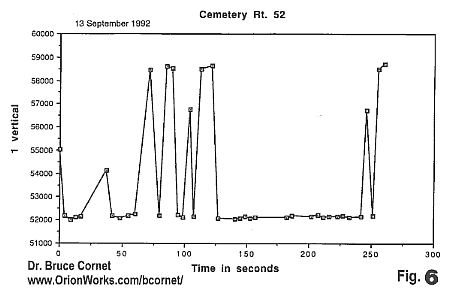
Martin also said that in August 1994 he and his wife Lynn had observed a beam of light originating from somewhere in the cemetery that tracked a commercial airliner as it passed low overhead one night (below cloud level). The time was between 9:00 pm and 10:00 pm, as they recalled. They had been standing on the north side of Rte 52 at a side road watching for AOP when the jetliner was spotted on approach to Stewart airport, located nine miles to the east. It was traveling from west to east. As it got close to the cemetery, both were shocked to see a beam of light project upwards, illuminate the underbelly of the aircraft as it flew over the cemetery, and then just as suddenly disappear when the aircraft had passed the cemetery.
As Crystall, Brock, and Cornet stood in the middle of the cemetery waiting for something to happen, Cornet noticed what at first looked like airplane lights descending below the clouds to the northwest. The time was about 11:00 pm. There were several lights of different color: White, red, green, and blue. Some of them were blinking like aircraft strobes. It was the blue light that kept his attention, however. But as we watched, the lights descended rapidly in an easterly direction and disappeared behind the tree line at the northern end of the corn field across the road.
Location map:
|
The only airstrip to the north belongs to the military - a Special Operations airbase, but no planes have ever been seen landing at that airstrip, which is used for other purposes. However, the lights did not appear to be far enough north to be headed for that airstrip. The lights appeared to disappear just behind a forest into another set of farm fields (see map above).
Spec Ops airstrip located more than three miles north of cemetery:
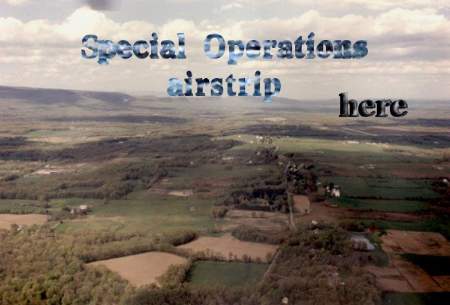
About 10 minutes later Crystall spotted a set of white lights on the distant side of the corn field across the road, and began videotaping them. On the videotape Crystall can be heard saying, "Fluttering in the trees," as the lights intermittently disappeared and reappeared as they passed behind some trees. We suspect that the AOP did not fly over the forest and swamp area (we would have seen that), but came through a break where a gravel road cuts through the forest at the northeast end of the field. The lights were quickly eliminated as car headlights when they turned and began flying west over the corn field, but below the tops of the trees. The low altitude of the object precluded a conventional aircraft, unless it was a stunt pilot putting on a show for us.
FAA regulation 91.177 Minimum altitude for IFR operations. (a) Operation of aircraft at minimum altitudes. Except when necessary for takeoff and landing, no person may operate an aircraft under IFR below - (1) The applicable minimum altitudes prescribed in Parts 95 and 97 of this chapter; or (2) If no applicable minimum altitude is prescribed in those parts -- (i) In the case of operations over an area designated a mountainous area in part 95, an altitude of 2,000 feet above the highest obstacle within a horizontal distance of 4 nautical miles from the course to be flown; or (ii) In any other case, an altitude of 1,000 feet above the highest obstacle within a horizontal distance of 4 nautical miles from the course to be flown (AIM/FAR 1994 airman's information manual / federal aviation regulations).
FAA regulation 91.303 Aerobatic flight. No person may operate an aircraft in aerobatic flight -- (a) Over any congested area of a city, town, or settlement; (b) Over an open air assembly of persons. For the purposes of this section, aerobatic flight means an intentional maneuver involving an abrupt change in an aircraft's altitude, an abnormal altitude, or abnormal acceleration, not necessary for normal flight.
That possibility, however, was quickly dismissed by the following events:
When the AOP got to the west side of the corn field (see map above), it momentarily disappeared behind a low hill. For it to have disappeared behind that hill, its altitude had to have been close to Crystall's estimate: 15 feet. But we only had to wait about half a minute before its lights reappeared as they rose directly over the top of that hill and headed straight for us. The hill is shown below (photo taken 18 December 1999) from the same perspective as the time exposures.
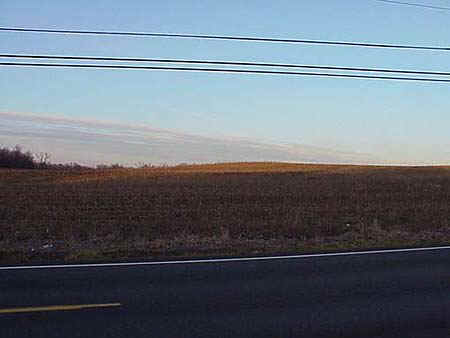
The hill and corn field can be seen behind Ellen Crystall in a picture taken by staff columnist Stephen Israel for an article on Crystall and Cornet. The article appeared in the 3 January 1993 Sunday Magazine distributed with the Times Herald Record, Middletown, NY. It is a picture taken the same year after harvesting.
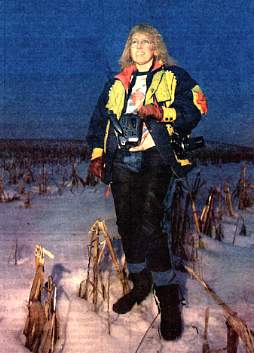
The AOP brightened its lights considerably as Cornet took his first time exposure (below). One minute and 49 seconds later Crystall said, "I hear a sound, but this is big," as the Manta Ray slowly approached us. Note the time on the animated gif below. Then she said, "Not enough lights on this thing," to be a conventional aircraft, that is.
Composite of four time exposures (click on image for more detail).
As the AOP approached we could hear a sound something like that of a jetliner, but it was different. At first a low wobble can be heard, then what sounds more like a diesel train passing. That sound (compiled from two sound clips to conserve space) can be heard by operating the sound control box at the top of this web page or by clicking the control below.
Even if it had been a jetliner, what was the pilot doing flying below FAA- regulated minimum altitude of 1,000 feet, not to mention below tree top level? As it approached it climbed in altitude so that it was at least 500 feet above us as it passed over us. It also arched or slowly turned towards the northwest. It took two minutes, 30 seconds (150 seconds) to travel from behind the low hill to directly over us, a distance of approximately 2,700 feet. Its maximum average speed (calculated at 11.7 mph) is well below the stall speed of a conventional jetliner or any fixed-wing aircraft dependent on wings for flight. There is no error in the map distance traveled, which is constrained by the size of the field, or in the time it took (recorded on video). The AOP seemed to take forever to reach us as it slowly crossed the field.
Watch the animated gif below, which shows the AOP initially flaring its lights, and then listen to the sounds it made, along with Crystall's comments.
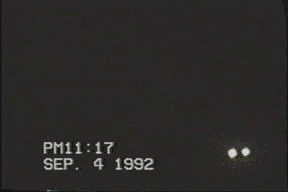 |
|
|
Download 9-4-92cx.wav (254K) by clicking on That's alien. |
Download 9-4-92cy.wav (249K) by clicking on Oh sure. |
Download 9-4-92cz.wav (171K) by clicking on Sound leaving. |
Did you get fooled?
Did you think the images and sounds are only those of a conventional jetliner? If you did, you are not a very good observer. Take another look-listen before reading on to find out the problems and how you were fooled. If you weren't fooled, then you might stand a chance at survival were our visitor hostile.
Problems for the Skeptic
Problem 1: During the first sound clip (9-4-92cx.wav) Crystall says, "That's alien. No lights underneath. They're all at the outer edges." The diamond-shaped Manta Ray was passing directly over us at the time. As it approached, two small white lights, one above the other, can be seen between the two outer larger white lights (see animation above). But the top small light quickly moves forward to a position well ahead of the bottom small light, then it moves downwards so that it was positioned to the left of the bottom light as the Manta Ray moved away.
Aircraft lights are fixed, and most forward-directed lights on conventional aircraft are blocked by the fuselage after the aircraft passes the observer. Not only that, but lights don't move or change position on conventional aircraft, unless they are reflections. But please explain how the reflection of a top light can be seen on the bottom of an aircraft when viewed from behind. Moving lights were a common phenomenon recorded for Pine Bush AOP.
An almost identical performance was captured on video near Millbrook, NY, on 20 August 2003: http://bcornet.homestead.com/files/Mantaray/Millbrook.htm. In that video the top nose light moved forward, then downward next to the bottom nose light, then backwards along the bottom of the craft. See for yourself. Measurements taken from video frames showed that the Manta Ray turned around before it came to a stop, traveling backwards.
Problem 2: The tail light is not seen until the Manta Ray is directly overhead. But in the very next shot in the animation, the tail light jumps forward as if the tail retracted. The amount of distance the AOP had traveled was not enough to account for a perspective change in apparent position of that light.
Problem 3: The outermost lights on conventional aircraft are wingtip or navigation lights. Typically there is a green starboard light and (two) red port lights which can be viewed only from the front or side of the plane, not from the rear. Behind them is a small white navigation light located at the end of a rear-projecting wingtip extension. This small white light can't be seen from the front of the plane, because it is blocked by the wing. There is also a white strobe fixture mounted in a circular window between the white rear light and the wing (see example below: Boeing 757).
|
|
|
Problem 4: When one looks at an enlargement of the lights on the Manta Ray,
one sees no evidence of shielding between the white light and red
light. The red light (top right of image below) appears
to pulse according to the movement of the white light, implying that its pulsing was
triggered by movement, which is not possible for conventional aircraft lights.
Although the green starboard light could have been shielded
by a wing, it is not apparent.
Close-up of lights when AOP was overhead:
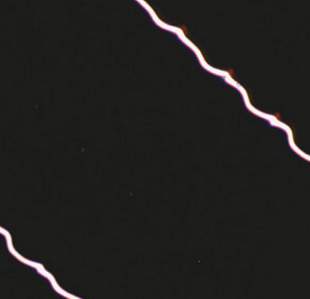
Problem 5: Wingtip lights cannot increase in brightness to that of landing lights, and these outermost lights of the Manta Ray clearly brightened (flared) to much brighter than landing lights, which has been a typical trademark of Pine Bush AOP. There is no logical reason to place landing lights at the wingtips of an aircraft when the pilot needs light directly in front of him. Most aircraft landing lights are located on the forward fuselage or on the wings next to the fuselage.
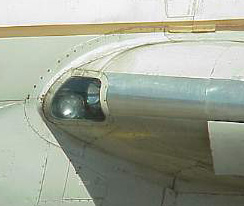
Problem 6: During the second sound clip (9-4-92cy.wav) Crystall says, "Nice sound," and then she says, "Geeez." The high pitch sound coming from the Manta Ray then increases in pitch, followed by her saying, "Oh sure!" Crystall was highly skeptical that the sound being produced was that of a conventional jetliner, and the increase in pitch seemed to have no functional purpose other than as an attempt to convince observers on the ground that all they were seeing was a conventional jet aircraft.
When the engines of a jetliner increase in pitch during flight, that usually means more thrust is being generated, but you cannot hear any sound of thrust coming from the AOP. And you should have heard a jet engine thrust sound, especially if it had been a conventional aircraft.
Problem 7: As the AOP approached us, its extremely low altitude (below tree top level at beginning of approach) precludes it from being a commercial jetliner. It could have been a stunt aircraft, but its size precludes it from having been a small aircraft. I have seen the Manta Ray rotate to a vertical position (e.g. port side down) without losing altitude (see The Performance or flight path on The Manta Ray).
Problem 8: Most slow-moving stunt planes are propeller-driven aircraft. Jet aircraft which can fly that slowly typically fall into the category of jump jets, such as the Harrier, but this was no Harrier. Its sound was not that of a propeller driven aircraft, nor that of a Harrier, nor that of a helicopter. We smelled no trace of burnt jet fuel after it passed over us (there was no significant wind that night), which we would have smelled had it been a jump jet traveling that slow.
Problem 9: Its apparent speed (11-12 mph) precludes it from having been a fixed-wing aircraft dependent on wings for lift.
Problem 10: Magnification of the first time exposures taken when the lights flared shows that the lights are not lamps, but plasmas. See web page on plasma orbs visible in the first two time exposures of this sighting. Distinct orbs can be seen in the plasma field, along with glowing orange brown gas due to the creation of Nitrous Oxides via atmospheric ionization.
Identification is based on what is known. Identification cannot be based on what is unknown. That is why the term U.F.O. is commonly used when a flying object does not fit the description of a conventional aircraft. Unfortunately, that term has come to mean "extraterrestrial" in the minds of the general public, but unidentified means unidentified. Because of this unfortunate association and double meaning, the term AOP (Anomalistic Observational Phenomena) is used here instead. It was originated by Robert Baker in 1968.
The AOP described on this web page has been dubbed the "Manta Ray." That does not mean that it is now identified, just because it has a name. What we can say definitively about this object are the following:
1) The AOP was a structured mechanical flying object which had lights and produced sounds. Its shape was geometric (i.e. solid and angular) with no visible indication of wings.
2) Its description, lighting characteristics, and flight characteristics do not fit anything conventional or manmade.
3) Many people have seen this AOP (or something similar) in the Hudson Valley region for more than a decade (since the early 1980's).
4) A book, Night Siege, was written about the thousands of eye witness sightings of this type of AOP in the area, but no one to date has been able to identify it or recognize it parked on some airport tarmac.
5) More observations are needed, using all the technical instruments currently available, before anything more definitive can be said about this object.
Perhaps the most disappointing aspect of this sighting and the many others which have taken place in the region is the continued official denial and lack of interest that someone or something is violating U.S. airspace with impunity. If it is military, where is the accountability to the taxpayers who have been paying the bills for so many performances and non-essential (and dangerous) low altitude flights? If it is extraterrestrial, why is there so much denial and persecution through ridicule and rejection by the scientific community? There is something radically wrong with this picture, and I am not talking about what was photographed in the field. The very spirit of scientific curiosity has been repressed and nearly snuffed out by those who, like Galileo's detractors, will not look through the telescope and become familiar with the evidence. There is no excuse for such behavior. Belief is irrelevant if not dangerous.
Could this enormous failure be Humankind's Achille's heel? A chain is only as strong as its weakest link.
References:
Baker, Robert M. L., Jr., 1968. Observational Evidence of Anomalistic Phenomena(1). Journal of the Astronautical Sciences Vol XV, No. 1. pp. 31-36.
Crystall, Ellen, 1991. Silent Invasion: The shocking discoveries of a UFO researcher, Paragon House, NY.
Hynek, J. Allen, Imbrogno, Philip J., and Pratt, Bob, 1987. Night Siege, The Hudson Valley UFO Sightings, Ballantine Books, New York.
Israel, Stephen, 1993. UFOs true believers, Middletown Record, Sunday Magazine edition, 3 January.
Copyright © 1999 Sirius Onion Works
Last modified: December 02, 2007